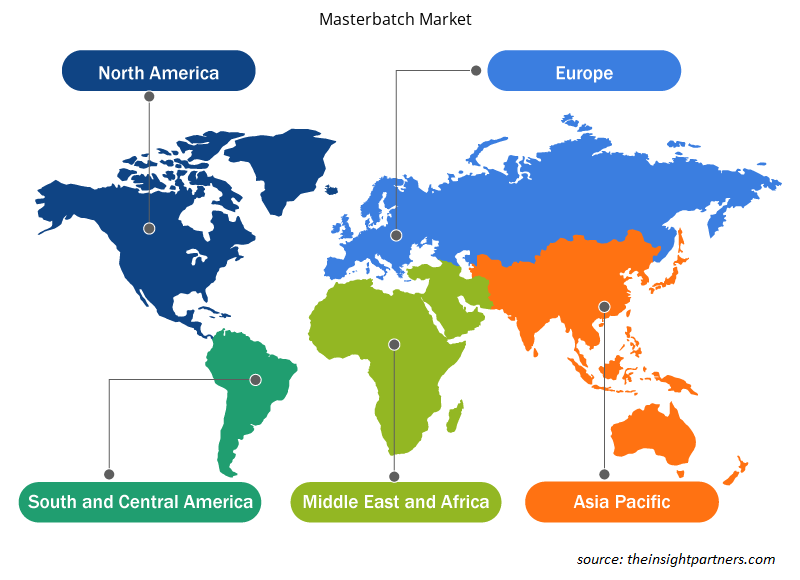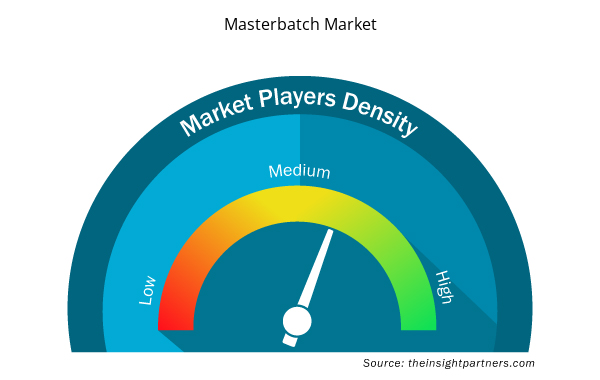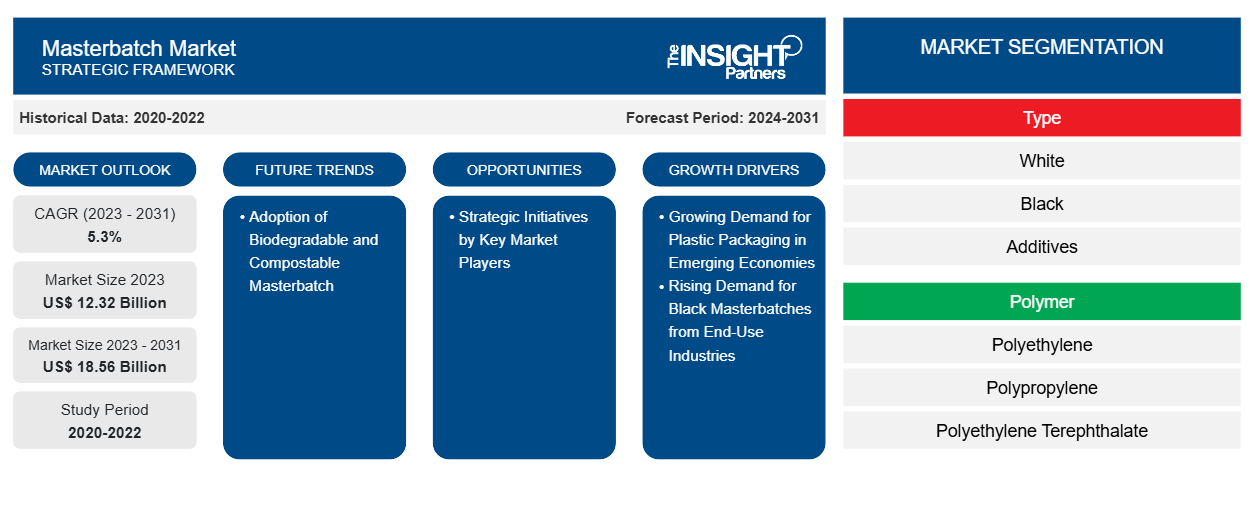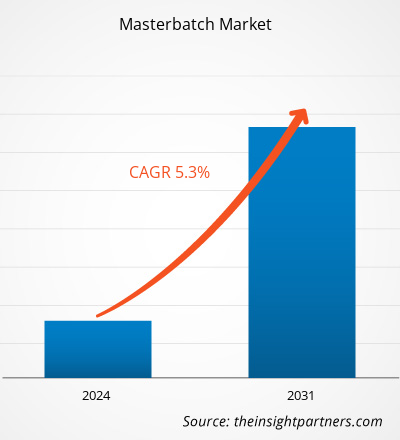2023 年色母粒市场价值为 123.2 亿美元,预计到 2031 年将达到 185.6 亿美元;预计 2023 年至 2031 年的复合年增长率为 5.3%。
市场洞察和分析师观点:
母粒可以包括在热处理过程中封装到载体树脂中的颜料、添加剂或填料,然后冷却并切成颗粒状。母粒的需求受到塑料行业和其他行业(如包装、汽车、建筑和消费品)的不断发展的推动。母粒通常用于生产片材、纤维、薄膜、注塑件和挤出型材。主要市场参与者提供各种产品,例如添加剂母粒、白色母粒、彩色母粒、特殊效果和填充母粒。此外,环境问题和有关塑料废物管理的法规影响了对可堆肥或可生物降解母粒的需求,从而有助于母粒市场的增长。
增长动力和挑战:
新兴经济体对塑料包装的需求不断增长,终端行业对黑色母粒的需求不断增长,这促进了母粒市场规模的扩大。中国、印度、日本和韩国等国家食品饮料和消费品等成熟行业的存在推动了亚太地区对包装解决方案的需求。由于包装行业的快速发展、食品零售业的增长以及消费者对可持续塑料包装系列的认识不断提高,亚太地区的塑料包装市场出现了显著增长。黑色母粒是母粒市场中一种经济高效且广受欢迎的选择。它主要用于薄膜、袋子、瓶子和容器等产品的包装应用。它具有不透明度、紫外线防护和美观性。黑色母粒还适用于生产软管和土工膜,因为它具有紫外线和热防护等特性。消费电子、包装、汽车、建筑和其他终端行业的增长推动了对黑色母粒的需求。新兴经济体对塑料包装的需求不断增长以及终端使用行业对黑色母粒的需求不断增加推动了母粒市场的发展。
原材料价格波动会抑制色母粒市场。用于制造色母粒的原材料在全球市场上作为商品进行交易,因此会受到商品市场动态的影响。原油衍生的聚合物会因各种因素而发生价格波动,包括供应链中断和需求波动。由于全球经济状况波动,原油价格上涨,导致树脂价格上涨。原油价格与聚合物成本之间的关系可以根据生产成本、市场波动、供应链影响和市场竞争等多种因素来确定。石油产品和其他原材料价格上涨会抑制产品的利润率,对色母粒市场构成挑战。
定制此报告以满足您的需求
您可以免费定制任何报告,包括本报告的部分内容、国家级分析、Excel 数据包,以及为初创企业和大学提供优惠和折扣
- 获取此报告的关键市场趋势。这个免费样品将包括数据分析,从市场趋势到估计和预测。
报告细分和范围:
“2031 年全球色母粒市场分析与预测”是一项专业而深入的研究,重点关注全球市场趋势和增长机会。该报告旨在提供市场概述,并按类型、聚合物和最终用途行业对市场进行详细细分。市场在最近经历了高增长,预计在预测期内将继续保持这一趋势。该报告提供了全球色母粒使用情况的关键统计数据。此外,全球色母粒市场报告对影响全球市场表现的各种因素进行了定性评估。该报告还包括对市场主要参与者及其关键战略发展的全面分析。进行了多项分析,以确定关键驱动因素、色母粒市场趋势和有利可图的机会,进而有助于确定主要收入来源。
母粒市场预测是根据各种二手和一手研究结果(如主要公司出版物、协会数据和数据库)估算的。此外,生态系统分析和波特五力分析提供了对市场的 360 度视角,有助于了解整个供应链和影响市场表现的各种因素。
节段分析:
全球母粒市场根据类型、聚合物和最终用途行业进行细分。根据类型,市场细分为白色、黑色、添加剂、颜色、填料和其他。白色部分在 2023 年占据了母粒市场的很大份额。白色母粒是一种用作聚合物制造中的着色剂的添加剂。它为着色剂提供白色色调。白色母粒含有高质量的二氧化钛等级,可以散射光线。在塑料工业中,白色母粒用于层压、涂层、保护膜、成型等。
根据聚合物,市场细分为聚乙烯、聚丙烯、聚对苯二甲酸乙二醇酯、聚苯乙烯等。聚乙烯部分在 2023 年占据了相当大的母粒市场份额。聚乙烯基母粒是添加剂和基础聚合物聚乙烯的浓缩混合物,旨在改善塑料和其他材料的性能。使用母粒制造的聚乙烯产品用于包装、汽车、建筑材料、消费品、农业、纺织和鞋类
根据最终用途行业,母粒市场细分为建筑和施工、汽车、包装、农业、电气和电子等。包装部门在 2023 年占据了相当大的市场份额。母粒在建筑和施工行业中得到广泛应用,因为它为各种建筑材料提供了各种优势和功能。建筑和施工中使用的塑料需要专门的添加剂来提高塑料的性能、抗拉强度和美观度。该行业使用母粒来获得颜色和美观、抗紫外线、阻燃性、能源效率以及抗静电和导电性能。
区域分析:
该报告详细概述了五大主要地区的市场——北美、欧洲、亚太地区 (APAC)、中东和非洲 (MEA) 以及南美和中美。就收入而言,亚太地区在色母粒市场占据主导地位。2023 年,该地区的市场价值超过 60 亿美元。按国家/地区划分,亚太市场分为澳大利亚、中国、印度、日本、韩国和亚太其他地区。色母粒用于制造汽车内饰和外饰零件,具有阻燃性、色散性和紫外线稳定性等多种特性。根据国际汽车制造商组织的报告,2022 年亚太地区的机动车产量估计为 4896 万辆。这些因素推动了亚太地区色母粒市场的增长。
预计到 2031 年,欧洲母粒市场规模将超过 20 亿美元。欧洲拥有多家大型包装公司,例如 Tetra Laval International SA、Amcor plc、Berry Global Group Inc、Smurfit Kappa Group plc、DS Smith plc、Ardagh Group SA 和 UPM-Kymmene Corp。防滑添加剂母粒用于薄膜包装,以增加聚乙烯薄膜或片材之间的摩擦系数。然而,可持续发展计划和循环经济法规进一步促使制造商开发可堆肥或可回收的母粒。因此,欧洲包装行业的发展推动了对母粒的需求。
预计北美色母粒市场在 2023-2031 年期间的复合年增长率约为 5%。根据美国涂料协会的数据,在美国,建筑涂料是涂料行业最大的部门和细分市场,占每年生产的涂料总量的 50% 以上。根据美国运输部联邦公路管理局的数据,美国政府于 2021 年签署了《基础设施投资和就业法案》,涵盖长期基础设施投资,在 2022-2026 财年提供 5500 亿美元用于道路、桥梁、公共交通和水利基础设施的建设。因此,北美建筑业的发展推动了该地区的色母粒市场。
色母粒市场区域洞察
Insight Partners 的分析师已详细解释了预测期内影响色母粒市场的区域趋势和因素。本节还讨论了北美、欧洲、亚太地区、中东和非洲以及南美和中美洲的色母粒市场细分和地理位置。

- 获取色母粒市场的区域特定数据
色母粒市场报告范围
| 报告属性 | 细节 |
|---|---|
| 2023 年的市场规模 | 123.2亿美元 |
| 2031 年市场规模 | 185.6亿美元 |
| 全球复合年增长率(2023 - 2031) | 5.3% |
| 史料 | 2020-2022 |
| 预测期 | 2024-2031 |
| 涵盖的领域 | 按类型
|
| 覆盖地区和国家 | 北美
|
| 市场领导者和主要公司简介 |
|
色母粒市场参与者密度:了解其对业务动态的影响
色母粒市场正在快速增长,这得益于最终用户需求的不断增长,这些需求源于消费者偏好的不断变化、技术进步以及对产品优势的认识不断提高等因素。随着需求的增加,企业正在扩大其产品范围,进行创新以满足消费者的需求,并利用新兴趋势,从而进一步推动市场增长。
市场参与者密度是指在特定市场或行业内运营的企业或公司的分布情况。它表明相对于给定市场空间的规模或总市场价值,有多少竞争对手(市场参与者)存在于该市场空间中。
在色母粒市场运营的主要公司有:
- “Avient 公司
- 安培赛特公司
- 卡博特公司
- 利安德巴塞尔工业公司
- 塑料克里蒂斯公司
- 宾夕法尼亚色彩公司
免责声明:上面列出的公司没有按照任何特定顺序排列。

- 获取色母粒市场顶级关键参与者的概述
行业发展和未来机遇:
根据公司新闻稿,以下是色母粒市场主要公司采取的一些举措:
- 2023 年,Ampacet Corporation 推出了 ColorMark 母粒添加剂技术。开发的产品与聚丙烯、聚苯乙烯、聚碳酸酯和聚酰胺兼容。母粒可产生永久且耐候的颜色,有六种流行颜色可供选择——红色、橙色、黄色、绿色、蓝色和紫色。
- 2023年,Penn Color Inc 在泰国开设了第一家生产工厂。该公司旨在为亚太地区市场供应高品质的着色剂和添加剂母粒。
- 2023年,卡博特公司推出了由可持续材料制成的循环黑色母粒REPLASBLAK。该公司推出了三款黑色母粒产品——REPLASBLAK rePE5475 100% 循环黑色母粒、REPLASBLAK rePE5265 70% 循环黑色母粒和 REPLASBLAK rePE5250 60% 循环黑色母粒。
竞争格局和重点公司:
Avient Corp、Ampacet Corporation、Cabot Corp、LyondellBasell Industries NV、Plastika Kritis SA、Penn Color Inc、Americhem、FRILVAM SPA、Polyvel Inc 和 Vanetti Spa 是色母粒市场报告中介绍的主要参与者。全球市场参与者专注于提供高质量的产品以满足客户需求。
- 历史分析(2 年)、基准年、预测(7 年)及复合年增长率
- PEST 和 SWOT 分析
- 市场规模价值/数量 - 全球、区域、国家
- 行业和竞争格局
- Excel 数据集


- Water Pipeline Leak Detection System Market
- Queue Management System Market
- Cling Films Market
- Integrated Platform Management System Market
- Virtual Event Software Market
- Virtual Pipeline Systems Market
- Sexual Wellness Market
- Biopharmaceutical Tubing Market
- Mobile Phone Insurance Market
- Aircraft Landing Gear Market

Report Coverage
Revenue forecast, Company Analysis, Industry landscape, Growth factors, and Trends

Segment Covered
This text is related
to segments covered.

Regional Scope
North America, Europe, Asia Pacific, Middle East & Africa, South & Central America

Country Scope
This text is related
to country scope.
常见问题
Asia Pacific accounted for the largest share in the global masterbatch market in 2023. As per the International Trade Administration, total investments in China's infrastructure during the 14th Five-Year Plan period (2021–2025) are estimated to reach ~US$ 4 trillion. According to the National Investment Promotion & Facilitation Agency, India allocated an investment budget of US$ 1.4 trillion in infrastructure under the National Infrastructure Pipeline by 2025, of which 18% accounted for roads and highways, 17% accounted for urban infrastructure, and 12% for railways.
Masterbatch manufacturers implement various strategic initiatives to maintain competitiveness, meet evolving customer demands, and capitalize on market opportunities. Masterbatch producers invest in research and development to innovate and introduce new products with enhanced properties, functionalities, and sustainable features.
The major players operating in the global masterbatch market are Avient Corp, Ampacet Corporation, Cabot Corp, LyondellBasell Industries NV, Plastika Kritis SA, Penn Color Inc, Americhem, FRILVAM SPA, Polyvel Inc, and Vanetti Spa.
Based on type, the market is segmented into white, black, additives, color, filler, and others. In 2023, the white segment held the largest masterbatch market share. The color segment is expected to register the highest CAGR from 2023 to 2031. White masterbatch is a type of additive used as a colorant in polymer manufacturing.
Masterbatch is widely used for coloring, UV stabilization, anti-block properties, and flame retardancy in plastic packaging solutions such as films, bottles, containers, sheets, and wraps. It offers several advantages such as precise color control, cost-effectiveness, ease of handling, and customization, making it a preferred choice for achieving desired properties in the packaging products.
Based on polymer, the market is segmented into polyethylene, polypropylene, polyethylene terephthalate, polystyrene, and others. The polyethylene segment held the largest masterbatch market share in 2023, and the polypropylene segment is expected to register a significant CAGR from 2023 to 2031. Polyethylene-based masterbatch is a concentrated blend of additives and a base polymer, polyethylene, which is designed to improve the properties of plastics and other materials.
Trends and growth analysis reports related to Chemicals and Materials : READ MORE..
The List of Companies - Masterbatch Market
- Avient Corp
- Ampacet Corporation
- Cabot Corp
- LyondellBasell Industries NV
- Plastika Kritis SA
- Penn Color Inc
- Americhem
- FRILVAM SPA
- Polyvel Inc
- Vanetti Spa
The Insight Partners performs research in 4 major stages: Data Collection & Secondary Research, Primary Research, Data Analysis and Data Triangulation & Final Review.
- Data Collection and Secondary Research:
As a market research and consulting firm operating from a decade, we have published and advised several client across the globe. First step for any study will start with an assessment of currently available data and insights from existing reports. Further, historical and current market information is collected from Investor Presentations, Annual Reports, SEC Filings, etc., and other information related to company’s performance and market positioning are gathered from Paid Databases (Factiva, Hoovers, and Reuters) and various other publications available in public domain.
Several associations trade associates, technical forums, institutes, societies and organization are accessed to gain technical as well as market related insights through their publications such as research papers, blogs and press releases related to the studies are referred to get cues about the market. Further, white papers, journals, magazines, and other news articles published in last 3 years are scrutinized and analyzed to understand the current market trends.
- Primary Research:
The primarily interview analysis comprise of data obtained from industry participants interview and answers to survey questions gathered by in-house primary team.
For primary research, interviews are conducted with industry experts/CEOs/Marketing Managers/VPs/Subject Matter Experts from both demand and supply side to get a 360-degree view of the market. The primary team conducts several interviews based on the complexity of the markets to understand the various market trends and dynamics which makes research more credible and precise.
A typical research interview fulfils the following functions:
- Provides first-hand information on the market size, market trends, growth trends, competitive landscape, and outlook
- Validates and strengthens in-house secondary research findings
- Develops the analysis team’s expertise and market understanding
Primary research involves email interactions and telephone interviews for each market, category, segment, and sub-segment across geographies. The participants who typically take part in such a process include, but are not limited to:
- Industry participants: VPs, business development managers, market intelligence managers and national sales managers
- Outside experts: Valuation experts, research analysts and key opinion leaders specializing in the electronics and semiconductor industry.
Below is the breakup of our primary respondents by company, designation, and region:

Once we receive the confirmation from primary research sources or primary respondents, we finalize the base year market estimation and forecast the data as per the macroeconomic and microeconomic factors assessed during data collection.
- Data Analysis:
Once data is validated through both secondary as well as primary respondents, we finalize the market estimations by hypothesis formulation and factor analysis at regional and country level.
- Macro-Economic Factor Analysis:
We analyse macroeconomic indicators such the gross domestic product (GDP), increase in the demand for goods and services across industries, technological advancement, regional economic growth, governmental policies, the influence of COVID-19, PEST analysis, and other aspects. This analysis aids in setting benchmarks for various nations/regions and approximating market splits. Additionally, the general trend of the aforementioned components aid in determining the market's development possibilities.
- Country Level Data:
Various factors that are especially aligned to the country are taken into account to determine the market size for a certain area and country, including the presence of vendors, such as headquarters and offices, the country's GDP, demand patterns, and industry growth. To comprehend the market dynamics for the nation, a number of growth variables, inhibitors, application areas, and current market trends are researched. The aforementioned elements aid in determining the country's overall market's growth potential.
- Company Profile:
The “Table of Contents” is formulated by listing and analyzing more than 25 - 30 companies operating in the market ecosystem across geographies. However, we profile only 10 companies as a standard practice in our syndicate reports. These 10 companies comprise leading, emerging, and regional players. Nonetheless, our analysis is not restricted to the 10 listed companies, we also analyze other companies present in the market to develop a holistic view and understand the prevailing trends. The “Company Profiles” section in the report covers key facts, business description, products & services, financial information, SWOT analysis, and key developments. The financial information presented is extracted from the annual reports and official documents of the publicly listed companies. Upon collecting the information for the sections of respective companies, we verify them via various primary sources and then compile the data in respective company profiles. The company level information helps us in deriving the base number as well as in forecasting the market size.
- Developing Base Number:
Aggregation of sales statistics (2020-2022) and macro-economic factor, and other secondary and primary research insights are utilized to arrive at base number and related market shares for 2022. The data gaps are identified in this step and relevant market data is analyzed, collected from paid primary interviews or databases. On finalizing the base year market size, forecasts are developed on the basis of macro-economic, industry and market growth factors and company level analysis.
- Data Triangulation and Final Review:
The market findings and base year market size calculations are validated from supply as well as demand side. Demand side validations are based on macro-economic factor analysis and benchmarks for respective regions and countries. In case of supply side validations, revenues of major companies are estimated (in case not available) based on industry benchmark, approximate number of employees, product portfolio, and primary interviews revenues are gathered. Further revenue from target product/service segment is assessed to avoid overshooting of market statistics. In case of heavy deviations between supply and demand side values, all thes steps are repeated to achieve synchronization.
We follow an iterative model, wherein we share our research findings with Subject Matter Experts (SME’s) and Key Opinion Leaders (KOLs) until consensus view of the market is not formulated – this model negates any drastic deviation in the opinions of experts. Only validated and universally acceptable research findings are quoted in our reports.
We have important check points that we use to validate our research findings – which we call – data triangulation, where we validate the information, we generate from secondary sources with primary interviews and then we re-validate with our internal data bases and Subject matter experts. This comprehensive model enables us to deliver high quality, reliable data in shortest possible time.


 获取此报告的免费样本
获取此报告的免费样本